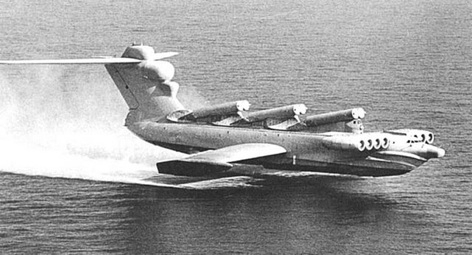I love ekranoplans. And I’m not alone.
For those not in the know, ekranoplans resemble a cross between seaplanes and hydrofoils. Essentially aircraft, they exploit a phenomenon called the wing-in-ground effect, where flying close to a surface gives a winged body extra lift.
Weird-looking things, ekranoplans. They tend to have stubby, wide wings; fuselages which turn into speedboat hulls at the bottom; dramatic, sweeping tailplanes; engines in odd places. And they can be huge. The best-known one is the ex-Soviet military Lun-class, often known in the West as the Caspian Sea Monster; weighing 400 tonnes and 73m long, it’s one of the largest aircraft ever built, with four turbojet engines mounted on either side of its cockpit and carrying six missile launchers in ridged dinosaur-like crests across its back.
The dinosaur aspect is part of its appeal, because ekranoplans are, to all intents and purposes, extinct. Although the Caspian Sea Monster was a spectacular sight when it was in service in the late ’80s, only one of the leviathans was ever to take to the seas, and it now sits, rusting massively and picturesquely, in a dock in the Russian city of Kaspiysk — a wonderful gallery of photos, taken by a Russian enthusiast, can be seen here. Although the Soviet Navy also used a smaller class of ekranoplan, they never really took off elsewhere, which is why the Russian name is usually used.

There’s a lot of enthusiasm around for this sort of other-worldly, dead-end technology. Ekranoplans, even though they’re in the past, seem to belong to a future that never happened; they’re a seductive vision of what might have been. Those romantic types among us like to think of worlds where transatlantic zeppelins plied the skies, while sleek ekranoplans skimmed the world’s great lakes and waterways. Who wouldn’t love to think of speeding above the surface of the English Channel or Lake Erie — or the Caspian, or the Black Sea — with a rooster-tail of spray rising behind the swept-back wings of a luxurious sea-skimmer?
You can see this retro-futurism everywhere. Whenever film-makers want to evoke an eerie alternative present, they stick some airships on the screen. The polished brass and varnished wood of Steampunk — an imagined Victoriana where steam technology was developed to an extreme and Babbage got the funding for his Difference Engine — is around everywhere, powered by appreciation for the satisfying clunk and whirr of mechanisms rather than the sterile, plastic-coated bleep of electronica and the beauty and individualism of the hand-crafted over the anonymity of mass-production. I believe that this may have some significance for the image of engineering, but that’s a matter for another blog.
But back to ekranoplans, and it seems that all is not lost for these spectacular watercraft. For the latest ekranoplan fan to come out of the closet is none other than swashbuckling aerospace pioneer Burt Rutan, founder of Scaled Composites, inventor of the X-prize winning SpaceShipOne and father of Virgin Galactic. Rutan’s latest project — he calls it his retirement project — is a hybrid ekranoplan/seaplane. Rutan is building the craft purely as a personal pleasure vehicle, planing to fly it over the lakes in Northern Idaho near his home, but he also wants it to be able to soar out of ground effect to fly to other lakes and rivers. A stylish water-hopper; it’s enough to gladden the heart of any retro-futurist.
And that’s not all. Although I haven’t been able to find any confirmation elsewhere, the wikipedia page for the Lun-class says that the Russian Ministry of Defence has approved a revival of construction of the craft, to begin next year. The mind boggles uneasily as to what plans Vladimir Putin might have for it, but the Caspian Sea Monster might fly again.










National Gas receives funding to develop Gravitricity underground hydrogen storage system
One single rock salt mine - Winsford - has 23 <i>MILLION </i>cubic metres of void and even allowing for 10% of that void set aside for hazardous waste...